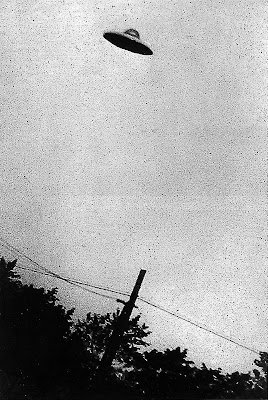CIA's Role in the Study of UFOs, 1947-90 A Die-Hard Issue, Historical Document by Gerald K. Haines who is the National Reconnaissance Office historian.
An extraordinary 95 percent of all Americans have at least heard or read something about Unidentified Flying Objects (UFOs), and 57 percent believe they are real. Former US Presidents Carter and Reagan claim to have seen a UFO. UFOlogists--a neologism for UFO buffs--and private UFO organizations are found throughout the United States. Many are convinced that the US Government, and particularly CIA, are engaged in a massive conspiracy and coverup of the issue. The idea that CIA has secretly concealed its research into UFOs has been a major theme of UFO buffs since the modern UFO phenomena emerged in the late 1940s.
In late 1993, after being pressured by UFOlogists for the release of additional CIA information on UFOs, DCI R. James Woolsey ordered another review of all Agency files on UFOs. Using CIA records compiled from that review, this study traces CIA interest and involvement in the UFO controversy from the late 1940s to 1990. It chronologically examines the Agency's efforts to solve the mystery of UFOs, its programs that had an impact on UFO sightings, and its attempts to conceal CIA involvement in the entire UFO issue. What emerges from this examination is that, while Agency concern over UFOs was substantial until the early 1950s, CIA has since paid only limited and peripheral attention to the phenomena.
 | Passoria New Jersey, July 31, 1952. Unless a copyright is indicated, information on the Central Intelligence Agency Web site is in the public domain and may be reproduced, published or otherwise used without the Central Intelligence Agency's permission. We request only that the Central Intelligence Agency be cited as the source of the information and that any photo credits or bylines be similarly credited to the photographer or author or Central Intelligence Agency, as appropriate. This file is a work of an employee of the Central Intelligence Agency, taken or made during the course of the person's official duties. As a work of the U.S. federal government, the file is in the public domain. Generally speaking, works created by U.S. Government employees are not eligible for copyright protection in the United States. See Circular 1 "COPYRIGHT BASICS" PDF from the U.S. Copyright Office. |
The emergence in 1947 of the Cold War confrontation between the United States and the Soviet Union also saw the first wave of UFO sightings. The first report of a "flying saucer" over the United States came on 24 June 1947, when Kenneth Arnold, a private pilot and reputable businessman, while looking for a downed plane sighted nine disk-shaped objects near Mt. Rainier, Washington, traveling at an estimated speed of over 1,000 mph. Arnold's report was followed by a flood of additional sightings, including reports from military and civilian pilots and air traffic controllers all over the United States. In 1948, Air Force Gen. Nathan Twining, head of the Air Technical Service Command, established Project SIGN (initially named Project SAUCER) to collect, collate, evaluate, and distribute within the government all information relating to such sightings, on the premise that UFOs might be real and of national security concern.
The Technical Intelligence Division of the Air Material Command (AMC) at Wright Field (later Wright-Patterson Air Force Base) in Dayton, Ohio, assumed control of Project SIGN and began its work on 23 January 1948. Although at first fearful that the objects might be Soviet secret weapons, the Air Force soon concluded that UFOs were real but easily explained and not extraordinary. The Air Force report found that almost all sightings stemmed from one or more of three causes: mass hysteria and hallucination, hoax, or misinterpretation of known objects. Nevertheless, the report recommended continued military intelligence control over the investigation of all sightings and did not rule out the possibility of extraterrestrial phenomena













No comments:
Post a Comment